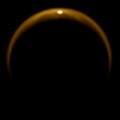Ficheiro:PIA12481 Titan specular reflection.jpg

Dimensões desta antevisão: 600 × 600 píxeis. Outras resoluções: 240 × 240 píxeis | 480 × 480 píxeis | 768 × 768 píxeis.
Imagem numa resolução maior (768 × 768 píxeis, tamanho: 35 kB, tipo MIME: image/jpeg)
Histórico do ficheiro
Clique uma data e hora para ver o ficheiro tal como ele se encontrava nessa altura.
| Data e hora | Miniatura | Dimensões | Utilizador | Comentário | |
|---|---|---|---|---|---|
| atual | 15h29min de 12 de dezembro de 2018 |  | 768 × 768 (35 kB) | Kesäperuna | 100% JPEG quality from full quality TIFF. |
| 07h16min de 18 de dezembro de 2009 |  | 768 × 768 (14 kB) | WolfmanSF | {{Information |Description={{en|1=This image shows the first flash of sunlight reflected off a lake on Saturn's moon Titan. The glint off a mirror-like surface is known as a specular reflection. This kind of glint was detected by the visual and infrared m |
Utilização local do ficheiro
A seguinte página usa este ficheiro:
Utilização global do ficheiro
As seguintes wikis usam este ficheiro:
- an.wikipedia.org
- ar.wikipedia.org
- be.wikipedia.org
- ca.wikipedia.org
- cs.wikipedia.org
- en.wikipedia.org
- en.wikinews.org
- en.wikiversity.org
- Solar System, technical/Titan
- Draft:Original research/Titan
- Astronomy college course/Miranda and Titan
- Astronomy college course/Miranda and Titan/questions
- OpenStax Astronomy/Test 3 Study guide
- Astronomy college course/Unit 3 study guide
- Wright State University Lake Campus/2016-1/Phy1060/T3 upgrade
- Wright State University Lake Campus/2017-1/Phy1060/printPDF
- Wright State University Lake Campus/2019-1/Phy1060/Old studyguide/Pdf
- Quizbank/All questions
- fr.wikipedia.org
- gl.wikipedia.org
- hy.wikipedia.org
- id.wikipedia.org
- it.wikipedia.org
- ja.wikipedia.org
- ka.wikipedia.org
- mk.wikipedia.org
- mwl.wikipedia.org
- no.wikipedia.org
- pl.wikipedia.org
- ro.wikipedia.org
- ru.wikipedia.org
- ta.wikipedia.org
- ta.wikinews.org
- uk.wikipedia.org
- vi.wikipedia.org
- xmf.wikipedia.org
Ver mais utilizações globais deste ficheiro.


